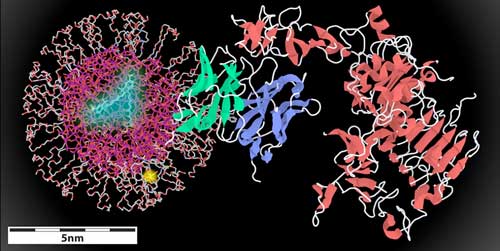| Posted: Oct 11, 2018 | |
Ultrasmall targeted nanoparticles with engineered antibody fragments as an anti-cancer weapon(Nanowerk News) Antibody-based imaging of a particularly aggressive form of breast cancer is undergoing clinical trials worldwide, but the path from trial to application is being hampered by a major obstacle: safety. |
|
| Concerns stem from inefficient tumor targeting, which can result in accumulation in the bone marrow, liver and kidneys of the radioactive material necessary for the imaging. Recent efforts have focused on nanoscale delivery vehicles with immune components, but these vehicles are often still too large (20 nanometers or larger) for renal clearance after imaging. | |
| Ulrich Wiesner, the Spencer T. Olin Professor of Engineering in materials science and engineering, in collaboration with Dr. Michelle Bradbury of Memorial Sloan Kettering Cancer Center (MSKCC) and Weill Cornell Medicine, has proposed a novel approach using ultrasmall silica nanoparticles – better known as “Cornell dots” (or C dots) – invented in his lab more than a dozen years ago. | |
| Their team – including researchers at pharmaceutical company MedImmune – have equipped the C dots with antibody fragments. Because the resulting conjugates are smaller than 8 nanometers, these C dots allow for renal clearance while achieving the specificity needed for efficient tumor targeting. | |
| They report their discovery in Nature Communications ("Ultrasmall Targeted Nanoparticles with Engineered Antibody Fragments for Imaging Detection of HER2-Overexpressing Breast Cancer"). Feng Chen, senior research scientist at MSKCC, and Kai Ma, postdoctoral researcher in the Wiesner lab, are co-lead authors. | |
 |
|
| A rendering of the Cornell prime dot (left) with an attached antibody fragment (center) binding to a HER2 cancer cell receptor (right). The dot and antibody attachment combined are less than 8 nanometers in diameter, the limit for renal clearance. (Image: Wiesner lab, Cornell University) | |
| Wiesner said this research creates “a whole new runway” to employ antibody fragments for a number of diseases, cancer in particular, and for diagnostics as well as drug delivery – when combined in a single entity also known as “theranostics.” | |
| “This is the first time we’ve worked with these antibody fragments,” Wiesner said, “thereby harnessing the power of antibodies in the fight against cancer.” | |
| Cornell dots and their newer generation – termed “Cornell prime dots,” or simply C’ dots – have evolved since Wiesner and his group introduced them in 2005 and since, in collaboration with Bradbury, a first clinical trial deemed them safe for humans in 2014. Two years ago, the dots were shown to have the ability not only to detect cancer cells but to be self-therapeutic thereby actually killing them. | |
| This latest research puts C dots back into the role of cancer-finder, but adds a “tumor finder” in the form of an antibody fragment. They used a particular fragment of the Y-shaped antibody, as opposed to the whole molecule, to keep the C’ dot within the size threshold for renal clearance. | |
| The target: HER2-positive breast cancer, more aggressive and deadly than HER2-negative cancer, making it an attractive target for new diagnostics and therapies. In the collaboration, MedImmune engineered an antibody fragment specifically to target the HER2 protein and a conjugation site not interfering with its binding activity. The groups of Wiesner and Bradbury, meanwhile, worked together to attach it to the C’ dot surface to keep the overall conjugate below 8 nanometers in diameter. | |
| The dot itself was synthesized in a way that gave it five distinct functions, all within its ultrasmall size of 6 to 7 nanometers. | |
| Both in vitro and in vivo (mouse) targeting of HER2-positive breast cancer cells were successful, with in vivo tumor uptake of the injected dots as high as 17.2 percent, the highest Wiesner and Bradbury have achieved in all of their C dot research. | |
| “The injection circulates through the blood and has to escape the vasculature, has to diffuse through the connective tissue, has to associate with the tumor and then kind of penetrate the tumor body,” Wiesner said. “We want 100 percent – everybody wants 100 percent. But when you consider all of the other things that are competing for the vehicle elsewhere in the body, 17 percent is not that small.” | |
| Bradbury, who along with Wiesner directs the MSK-Cornell Center for Translation of Cancer Nanomedicines, calls the C’ dot a “game-changer” in nanoparticle-based drug delivery. | |
| “These research findings are very exciting,” she said, “as they suggest we could specifically deliver a variety of small molecule therapies – chemotherapy, inhibitors and radiotherapy – without the toxicity typically found using larger particle probes.” |
| Source: Cornell University | |
|
Subscribe to a free copy of one of our daily Nanowerk Newsletter Email Digests with a compilation of all of the day's news. |
